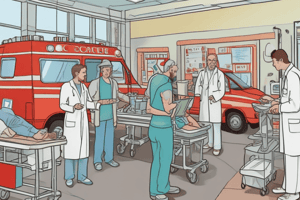Podcast
Questions and Answers
What is the purpose of a dressing in first aid?
What is the purpose of a dressing in first aid?
- Control bleeding
- Absorb liquid from the wound
- Immobilize body parts
- Protect the wound from infection (correct)
Which action should be taken during the initial response to an emergency situation?
Which action should be taken during the initial response to an emergency situation?
- Ask for help (correct)
- Give detailed instructions
- Gathering of materials
- Plan of action
What should be done to prevent further harm in an emergency situation?
What should be done to prevent further harm in an emergency situation?
- Do not further harm (correct)
- Provide detailed instructions
- Immobilize the patient
- Control bleeding
What is the purpose of bandages in first aid?
What is the purpose of bandages in first aid?
What is the first step in giving emergency care according to the guidelines?
What is the first step in giving emergency care according to the guidelines?
How should a helper be instructed in providing first aid care?
How should a helper be instructed in providing first aid care?
What is the role of elastic roller bandages in first aid?
What is the role of elastic roller bandages in first aid?
Why is it important to establish emergency plans based on anticipated needs?
Why is it important to establish emergency plans based on anticipated needs?
What should be done when providing emergency care to a patient?
What should be done when providing emergency care to a patient?
What is the purpose of gloves in first aid?
What is the purpose of gloves in first aid?
Flashcards are hidden until you start studying
Study Notes
Normal Ranges for Vital Signs
- Adult: 12-20 breaths/min, 60-100 beats/min
- Child: 18-25 breaths/min, 80-100 beats/min
- Infant: 25-35 breaths/min, 100-120 beats/min
Head-to-Toe Examination
- Deformities
- Contusions
- Abrasions
- Punctures/penetrations
- Burns
- Tenderness
- Lacerations
- Swelling
Pupillary Reactions
- Constricted Pupils: Heat Stroke, Drug overdose
- Dilated Pupils: Shock, Bleeding
- Unequal Pupils: Head Injury, Stroke
Patient Casualty Handling
- Emergency Rescue: rapid movement of patient from unsafe to a safe place
- Indications for Emergency Rescue: danger of fire, toxic gases, serious traffic hazards, risk of drowning, electrocution, collapsing walls
Transfer of Patient
- Selection of transfer method depends on:
- Nature and severity of injury
- Size of the victim
- Physical capabilities of the first aider
- Number of personnel and equipment available
- Nature of evacuation route
- Distance to be covered
- Sex of the victim (last consideration)
Triage
- Process of sorting patients into categories of priority for care and transport
- S.T.A.R.T. System: Simple Triage And Rapid Treatment
- Tagging of Patient:
- Priority One (Red Tag): immediate care, life-threatening
- Priority Two (Yellow Tag): delayed care, can delay transport and treatment up to 1 hour
- Priority Three (Green Tag): hold care, can delay transport up to 3 hours
- Priority Four (Black Tag): no care required, patient is dead
Bandaging
- Parts of the Triangular Bandage: Apex, Side, Face, Tail, Base
- Bandaging Techniques:
- Folding of the Triangular Bandage
- Different Knots: Simple Knot, Square Knot, Surgeons' Knot
- Open Phase, Broad Cravat, Semi Broad Cravat, Narrow Cravat
Lifting and Moving
- One Man Lifting and Moving: Walking Assist, Cradle Carry, Pack Strap Carry, Firefighter's Carry
- One Man Drag: Armpit or Clothes Drag, Ankle Drag (aka Foot Drag)
- Two Man Lifting and Moving: Extremity Carry, Swing Carry (two-handed seat or arms-as-litter)
Immobilization
- Equipment: Spine Board, Kendrick's Extrication Device (KED), Sets of Splints, Poles and Blankets, Commercial Stretchers
First Aid Kit
- Content: Rubbing alcohol, Povidone Iodine, Cotton Gauge pads, Tongue depressor, Penlight, Band aid, Plaster, Gloves, Scissors, Forceps, Bandage (Triangular), Elastic roller bandage, Occlusive dressing
Dressings and Bandages
- Dressing: sterile cloth materials used to cover the wound
- Uses of dressing: control bleeding, protect the wound from infection, absorb liquid from the wound
- Bandages: clean cloth materials, sterile or not, used to hold the dressing in place
- Uses of bandages: control bleeding, tie splints in place, immobilize body part, arm support - use as a sling
Guidelines in Giving Emergency Care
- GETTING STARTED:
- Plan of Action
- Gathering of Needed Materials
- Initial Response: Ask for HELP, Intervene, Do no further harm
- Instruction to Helper/s: provide organized first aid care
- EMERGENCY ACTION PRINCIPLES:
- Principle 1
Studying That Suits You
Use AI to generate personalized quizzes and flashcards to suit your learning preferences.



